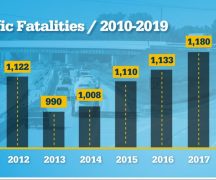Ohio Capital Journal
Ohio’s redistricting process is in a state of turmoil, with a delay in Census data leading the state to worry about there not being enough time to adequately draw new legislative maps.
Republicans and Democrats have both presented plans for how Ohio can deal with these delays. In essence, legislative leaders from both parties want to push back the deadline for completing the new maps that will be in place starting in the 2022 elections.
But the sides propose two very different ways to achieve that goal.
The next few days will be critical as Ohio lawmakers determine the preferred way of moving forward. The results from this week could have lasting implications for Ohio’s legislative government over the coming decade.
Not how Ohio voters drew it up
Each decade, Ohio redraws its federal legislative seats in the U.S. House of Representatives and state legislative seats in both the Ohio Senate and Ohio House of Representatives.
This is done to reflect changes in population and coincides with the U.S. Census, which is also conducted every 10 years.
After the last redistricting effort a decade ago, Ohio voters chose to reform the process for this year and the decades to follow. In short, voters approved a new system which puts a greater emphasis on transparency and bipartisanship.
These new plans — for federal and state maps — were approved via constitutional amendments on the 2018 and 2015 ballots, respectively.
These plans set specific deadlines to meet during the redistricting process.
Ohio voters could not have anticipated a global pandemic would occur at the same time the U.S. Census Bureau conducted its decennial count of American residents. The pandemic not only made the count more difficult, but has led to delays in processing and distributing census data used by officials to draw new legislative districts.
The Census Bureau announced this redistricting data will be provided to states by Sept. 30.
That’s a major problem — Ohio would therefore miss its redistricting deadlines:


Plan A involved a federal lawsuit from Attorney General Dave Yost seeking to get the redistricting data released earlier. The case was quickly dismissed. Now the two parties are offering some ideas for Plan B.
Back to the drawing board
If the government won’t release data early enough to match Ohio’s deadlines, officials here propose shifting the deadlines back to account for the late data.
This is not an easy fix. The 2021 deadlines were approved by voters and are thus embedded in the Ohio Constitution.
Senate President Matt Huffman, R-Lima, suggests the state get approval from voters to move back the deadlines as part of a one-time fix for this unique circumstance.

Screenshot courtesy the Ohio Channel.
The next opportunity to get a constitutional amendment before Ohio voters would be the Aug. 3 special election.
Both chambers of the Ohio General Assembly (House and Senate) would have to pass a joint resolution to place the constitutional amendment on the August ballot. A three-fifths majority is required in each chamber for passage.
The deadline for filing this joint resolution with the Ohio Secretary of State’s Office is 90 days before the August election — that’s this Wednesday, May 5.
It’s possible, but the Republican leadership would need to work quickly. As of Monday morning a joint resolution has not yet been formally introduced.
An amendment requires a majority statewide vote to pass.

Democratic leaders in the General Assembly say there are better options for handling the census delays than a hurried constitutional amendment attempt.
House Minority Leader Emilia Strong Sykes, D-Akron, and Senate Minority Leader Kenny Yuko, D-Richmond Heights, outlined their party’s own take on Friday for how to move forward.
“Constitutional amendments should be our final options,” Sykes argued, “not our first.”
The Democrats believe the best option is to ask the Ohio Supreme Court for an extension of the deadlines as other states, including Michigan, have done.

Source: The Ohio General Assembly.
“I think (the Supreme Court) could understand that the people have spoken loud and clear, twice already, asking us to put an end to gerrymandering,” Yuko said. “What we’re proposing will do just that.”
While both plans call for extending the redistricting deadlines, neither party is suggesting to push back the 2022 primary election day to keep the full timeline intact.
All On The Line Ohio, a left-leaning organization which advocates for a fair mapmaking process, is calling for the primary election to get pushed back by a few weeks.
Sykes and Yuko said the Democrats would be introducing a plan to ensure the public has an adequate chance to provide input during what could be a truncated redistricting timeline.
***
Also from Ohio Capital Journal:
OSU study: Hispanic COVID-19 deaths disproportionately high
A study done by Ohio State University researchers showed the COVID-19 pandemic had a particularly fatal impact on the Hispanic community.
Using CDC death counts separated by racial/ethnic group, the study showed that Hispanics constituted 40%, but only represented 19% of the population in 2020.
Deaths among the Hispanic population were disproportionately high in every age range below the age of 75, the study showed, and CDC surveillance data sited in the research found a county-to-county pattern as well. READ MORE
Dental care remains neglected in state & nation
One of the leading health care needs in the state of Ohio is one that’s most neglected, especially when it comes to low-income communities.
As dental director at the Cincinnati Health Department and as part of the CincySmiles dental clinic program, Dr. Larry Hill’s major task was making sure low-income and high risk populations had access to oral health services, something he says isn’t enough of a priority in the state.
“It’s been a decades long battle to try to do something about this,” Hill said. “Oral health is…connected to everything else (in health), but it’s been forgotten in most state and national health policy.”
Hill said it’s hard to understand how dental care has been overlooked by state legislation, federal measures and insurance companies alike, when the small area of the mouth makes so much of a difference in overall health. READ MORE




